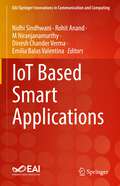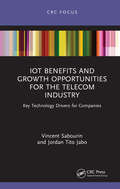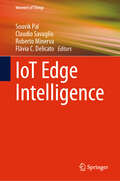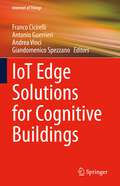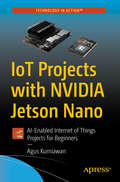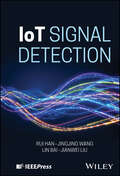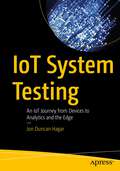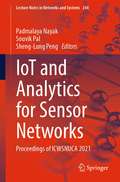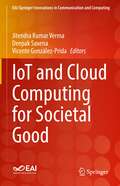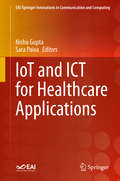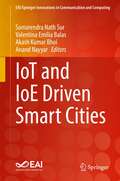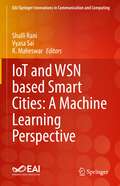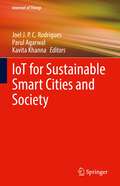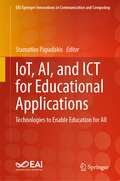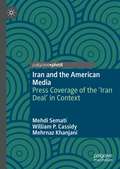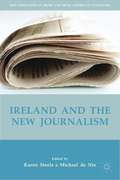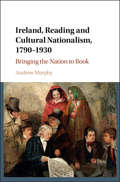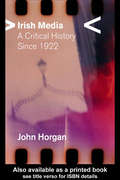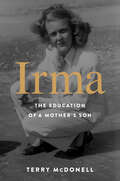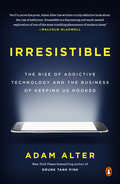- Table View
- List View
IoT Based Control Networks and Intelligent Systems: Proceedings of 4th ICICNIS 2023 (Lecture Notes in Networks and Systems #789)
by Marcelo S. Alencar Przemyslaw Falkowski-Gilski P. P. JobyThis book gathers selected papers presented at International Conference on IoT Based Control Networks and Intelligent Systems (ICICNIS 2023), organized by School of Computer Science and Engineering, REVA University, Bengaluru, India, during June 21–22, 2023. The book covers state-of-the-art research insights on Internet of things (IoT) paradigm to access, manage, and control the objects/things/people working under various information systems and deployed under wide range of applications like smart cities, healthcare, industries, and smart homes.
IoT Based Smart Applications (EAI/Springer Innovations in Communication and Computing)
by Dinesh Chander Verma Nidhi Sindhwani Rohit Anand M Niranjanamurthy Emilia Balas ValentinaThis book provides insights into IoT, its applications, and various implementation techniques. The authors first discuss the IoT design methodology to define the domain model. They then cover various connection methodologies used in IoT such as Ethernet, Wi-Fi, low powered wide area network (LPWAN), Bluetooth, RFID, cellular, and satellite, and more, along with their challenges. An example is made on the designing process using Arduino, which offers smart, connected, and secure elements; they also illustrate the integration of IoT with Blockchain, cloud, machine learning, big data, embedded software, sensors, etc. The book going on to cover the future of IoT in various sectors and how IoT will continue to be game-changing technology.
IoT Benefits and Growth Opportunities for the Telecom Industry: Key Technology Drivers for Companies
by Vincent Sabourin Jordan Tito JaboThis critical and forward-looking book features: An assessment of the impact of Internet of Things (IoT) on the telecom industry’s revenue streams IoT-based business models in the telecom industry A PESTLE (political, economic, socio-cultural, technological, legal, and environmental) analysis of the industry in relation to IoT Key technological drivers. It also features a case study of Bell Canada Enterprises (BCE) Inc., which highlights IoT-based business models in the industry. The study reveals that telecom operators have started implementing IoT projects, however, true revenue streams are yet to materialize. Ten IoT-based business models have been identified at BCE Inc. The book points out that operators do leverage existing infrastructure in terms of broadband fiber and mobile connectivity in part and resort to partnerships and acquisitions to acquire much-needed knowledge, technology, and smart devices. Concerning the effect of IoT on the telecoms’ revenue streams, it was revealed that new entrants, who are not necessarily in the telecom industry, have impacted the old players’ revenue streams. OTT services like YouTube, WhatsApp, IPTV, Netflix, are the biggest culprits. Seven key technological drivers for IoT have been identified and include widespread wireless connectivity, the availability and affordability of microcontrollers, sensors and actuators, the decreasing cost of bandwidth, the recent implementation of IPv6, and the ongoing development of 5G network, as well as the use of cloud computing and analytics. Finally, the PESTLE analysis of the industry shows that the lack of a comprehensive political and regulatory framework still slows down IoT deployment. Interoperability, security, and privacy concerns are other constraints. Conversely, general economic conditions in most developed and developing economies are favorable to the advancement of IoT technology. Governments are willing to subsidize R&D and have partnered with the private sector to speed up the roll-out process.
IoT Communication Performance Analysis (Transactions on Computer Systems and Networks)
by Chuzo NinagawaThis book deals with analysis techniques for TCP, UDP, Web, and SOAP data transmission performance on the IoT cloud side, CSMA-type, and multi-hop data transmission performance on the IoT edge side, as well as gateway receives buffer and transmit packet assembly data transmission performance.As mathematical tools for the analysis of communication performance, universal analysis methods such as stochastic processes, queues, Markov processes, and communication traffic simulators are applied to actual examples, and their usage is described in detail. This book aims to provide lifelong skills for analyzing communication performance that will serve as the basis for the future evolution of the IoT.
IoT Edge Intelligence (Internet of Things)
by Flávia C. Delicato Roberto Minerva Souvik Pal Claudio SavaglioThis book explores fundamental and advanced concepts related to the AI-enabled Edge Technology paradigm, also known as Edge Intelligence, within the framework of the Internet of Things (IoT). Expanding the application of Edge computing is increasingly necessary. This can involve exploring automated, intelligent computational learning theorems, and ANN-oriented, trustworthy machine learning perspectives to enhance computational intelligence. The book functions as a valuable resource for professionals in the sector and also acts as a comprehensive learning tool for newcomers in the field of AI-enabled Edge Technologies and their applications, covering both fundamental and advanced concepts. This book uses data and network engineering and intelligent decision support system-by-design principles to design a reliable IoT edge-cloud ecosystem and to implement cyber-physical pervasive infrastructure solutions. The book will help readers understand the design architecture and AI algorithms and learn analytics through IoT edge, device-edge and the state-of-the-art in cloud-IoT countermeasures. The book is a valuable reference for anyone doing undergraduate or postgraduate studies, conducting research, or working in the computer science, information technology, electronics engineering, and complicated mathematical modeling domains.
IoT Edge Solutions for Cognitive Buildings (Internet of Things)
by Antonio Guerrieri Giandomenico Spezzano Franco Cicirelli Andrea VinciThis book outlines the promise of the field of the Cognitive Internet of Things when it is applied to cognitive buildings. After an introduction, the authors discuss the goals of cognitive buildings such as operation in a more efficient, flexible, interactive, intuitive, and sustainable way. They go on to outline the benefits that these technologies promise to building owners, occupants, and their environments that range from reducing energy consumption and carbon footprint to promoting health, well-being, and productivity. The authors outline technologies that provide buildings and equipment with the ability to collect, aggregate, and analyze data and how this information can be collected by sensors and related to internal conditions and settings, energy consumption, user requests, and preferences to maintain comfort and save energy. This book is of interest to practitioners, researchers, students, and professors in IoT and smart cities.
IoT Enabled Computer-Aided Systems for Smart Buildings (EAI/Springer Innovations in Communication and Computing)
by Maitreyee Dutta Gonçalo Marques Jagriti SainiThis book focuses on the integration of IoT and computer aided systems for the development of smart buildings. The scope of the book includes, but is not restricted to, advanced technologies for monitoring, energy management, smart gardening, protection, safety, assisted living, and intelligent operations. The authors cover the wide aspects of interconnected smart services with convenient interfacing to the end-users. The features of this book include discussion on various aspects of IoT and computer aided systems for smart architecture designs and innovative object interconnections. The book also provides highlights on the applications of IoT in the development of intelligent structures for technology-enabled lifestyles. Furthermore, it provides prominent scopes for future inventions in the field of electrical engineering, building system management, and computer-aided advancements. The content of this book is useful to graduate and post-graduate students, researchers, and professionals working on the concept of smart building, smart city, and smart environments.
IoT Projects with Arduino Nano 33 BLE Sense: Step-By-Step Projects for Beginners
by Agus KurniawanGet started with the extremely versatile and powerful Arduino Nano 33 BLE Sense, a smart device based on the nRF52840 from Nordic semiconductors. This book introduces you to developing with the device.You'll learn how to access Arduino I/O such as analog and digital I/O, serial communication, SPI and I2C. The book also covers how to access sensor devices on Arduino Nano 33 BLE Sense, how to interact with other external devices over BLE, and build embedded Artificial Intelligence applications.Arduino Nano 33 BLE Sense consists of multiple built-in sensors such as 9-axis inertial, humidity, temperature, barometric, microphone, gesture, proximity, light color and light intensity sensors. With this book, you'll see how this board supports the Bluetooth Low Energy (BLE) network, enabling interactions with other devices over the network.What You’ll LearnPrepare and set up Arduino Nano 33 BLE Sense boardOperate Arduino Nano 33 BLE Sense board hardware and softwareDevelop programs to access Arduino Nano 33 BLE Sense board I/OBuild IoT programs with Arduino Nano 33 BLE Sense boardWho This Book Is ForMakers, developers, students, and professionals at any level interested in developing with the Arduino Nano 33 BLE Sense board.
IoT Projects with NVIDIA Jetson Nano: AI-Enabled Internet of Things Projects for Beginners
by Agus KurniawanExplore the capabilities of the NVIDIA Jetson Nano, an IoT device designed to perform computations like a computer desktop. This book will show you how to build your first project and optimize your devices, programs, and daily activities with the AI computation abilities of the Jetson Nano. This board consists of CPU Quad-core ARM A57 @ 1.43 GHz and GPU 128-core Maxwell. With this hardware specification, the board can run multiple neural networks in parallel for complex AI applications. With the integrated sensor and actuators, this board enables stronger IoT solutions and provides more advanced capabilities.Discover how develop complex IoT projects with the Jetson Nano today.What You’ll LearnSet up NVIDIA Jetson Nano deviceBuild applications like image classification, object detection, segmentation, and speech processingUse the Jetson Nano to process daily computer activities such as browsing the internet, checking emails, or playing music and videosImplement machine learning computations into your projectsWho This Book Is ForMakers, developers, students, and professional of all levels who are new to the NVIDIA Jetson Nano technology.
IoT Security: Advances in Authentication
by Madhusanka LiyanageAn up-to-date guide to an overview of authentication in the Internet of Things (IoT) The Internet of things (IoT) is the network of the countless physical devices that have the possibility to connect and exchange data. Among the various security requirements, authentication to the IoT is the first step to prevent the impact of attackers. IoT Security offers an important guide into the development of the many authentication mechanisms that provide IoT authentication at various levels such as user level, device level and network level. The book covers a wide range of topics including an overview of IoT and addresses in detail the security challenges at every layer by considering both the technologies and the architecture used. The authors—noted experts on the topic—provide solutions for remediation of compromised security, as well as methods for risk mitigation, and offer suggestions for prevention and improvement. In addition, IoT Security offers a variety of illustrative use cases. This important book: Offers an authoritative reference designed for use by all IoT stakeholders Includes information for securing devices at the user, device, and network levels Contains a classification of existing vulnerabilities Written by an international group of experts on the topic Provides a guide to the most current information available on IoT security Written for network operators, cloud operators, IoT device manufacturers, IoT device users, wireless users, IoT standardization organizations, and security solution developers, IoT Security is an essential guide that contains information on security features, including underlying networks, architectures, and security requirements.
IoT Signal Detection
by Lin Bai Rui Han Jingjing Wang Jianwei LiuComprehensive reference covering signal detection for random access in IoT systems from the beginner to expert level With a carefully balanced blend of theoretical elements and applications, IoT Signal Detection is an easy-to-follow presentation on signal detection for IoT in terms of device activity detection, sparse signal detection, collided signal detection, round-trip delay estimation, and backscatter signal division, building progressively from basic concepts and important background material up to an advanced understanding of the subject. Various signal detection and estimation techniques are explained, e.g., variational inference algorithm and compressive sensing reconstruction algorithm, and a number of recent research outcomes are included to provide a review of the state of the art in the field. Written by four highly qualified academics, IoT Signal Detection discusses sample topics such as: ML, ZF, and MMSE detection, Markov chain Monte Carlo-based detection, variational inference-based detection, compressive sensing-based detection Sparse signal detection for multiple access, covering Bayesian compressive sensing algorithm and structured subspace pursuit algorithm Collided signal detection for multiple access using automatic modulation classification algorithm, round-trip delay estimation for collided signals Signal detection for backscatter signals, covering central limited theorem-based detection including detection algorithms, performance analysis, and simulation results Signal design for multi-cluster coordination, covering successive interference cancellation design, device grouping and power control, and constructive interference-aided multi-cluster coordination With seamless coverage of the subject presented in a linear and easy-to-understand way, IoT Signal Detection is an ideal reference for both graduate students and practicing engineers in wireless communications.
IoT System Testing: An IoT Journey from Devices to Analytics and the Edge
by Jon Duncan HagarTo succeed, teams must assure the quality of IoT systems. The world of technology continually moves from one hot area to another; this book considers the next explosion—of IoT—from a quality testing viewpoint. You'll first gain an introduction to the Internet of Things (IoT), V&V, and testing. Next, you'll be walked through IoT test planning and strategy over the full life cycle, including the impact of data analytics and AI. You will then delve deeper into IoT security testing and various test techniques, patterns, and more. This is followed by a detailed study of IoT software test labs, architecture, environments and AI. There are many options for testing IoT qualities based on the criticality of the software and risks involved; each option has positives, negatives, as well as cost and schedule impacts. The book will guide start-up and experienced teams into these paths and help you to improve the testing and quality assessment of IoT systems. What You Will LearnUnderstand IoT software test architecture and planningMaster IoT security testing and test techniquesStudy IoT test lab automation and architecturesReview the need for IoT security, data analytics, AI, Neural Networks and dependability using testing and V&V Who This Book Is ForReaders with basic knowledge of software development who want to learn more about IoT testing and its intricacies, as well as companies moving into the domain of IoT, and even those already deep into the IoT domain will benefit from this book.
IoT and Analytics for Sensor Networks: Proceedings of ICWSNUCA 2021 (Lecture Notes in Networks and Systems #244)
by Sheng-Lung Peng Souvik Pal Padmalaya NayakThis book includes high-quality research papers presented at the 1st International Conference on Wireless Sensor Networks, Ubiquitous Computing and Applications (ICWSNUCA, 2021), which is held at Gokaraju Rangaraju Institute of Engineering and Technology, Hyderabad, India, during 26–27 February, 2021. This volume focuses on the applications, use-cases, architectures, deployments, and recent advances of wireless sensor networks as well as ubiquious computing. Different research topics are illustrated in this book, like wireless sensor networks for the Internet of Things; IoT applications for eHealth; smart cities; architectures for WSNs and IoT, WSNs hardware and new devices; low-power wireless technologies; wireless ad hoc sensor networks; routing and data transfer in WSNs; multicast communication in WSNs; security management in WSNs and in IoT systems; and power consumption optimization in WSNs.
IoT and Cloud Computing for Societal Good (EAI/Springer Innovations in Communication and Computing)
by Jitendra Kumar Verma Deepak Saxena Vicente González–Prida DíazThis book gathers the state-of-the-art for industrial application of scientific and practical research in the Cloud and IoT paradigms to benefit society. The book first aims to discuss and outline various aspects of tackling climate change. The authors then discuss how Cloud and IoT can help for digital health and learning from industrial aspects. The next part of book discusses technical improvements in the fields of security and privacy. The book also covers Smart Homes and IoT in agriculture. The book is targeted towards advancing undergraduate, graduate, and post graduate students, researchers, academicians, policymakers, various government officials, NGOs, and industry research professionals who are currently working in the field of science and technology either directly or indirectly to benefit common masses.
IoT and ICT for Healthcare Applications (EAI/Springer Innovations in Communication and Computing)
by Nishu Gupta Sara PaivaThis book provides an insight on the importance that Internet of Things (IoT) and Information and Communication Technology (ICT) solutions can have in taking care of people's health. Key features of this book present the recent and emerging developments in various specializations in curing health problems and finding their solutions by incorporating IoT and ICT. This book presents useful IoT and ICT applications and architectures that cater to their improved healthcare requirements. Topics include in-home healthcare services based on the Internet-of-Things; RFID technology for IoT based personal healthcare; Real-time reporting and monitoring; Interfacing devices to IoT; Smart medical services; Embedded gateway configuration (EGC); Health monitoring infrastructure; and more.Features a number of practical solutions and applications of IoT and ICT on healthcare;Includes application domains such as communication technology and electronic materials and devices;Applies to researchers, academics, students, and practitioners around the world.
IoT and IoE Driven Smart Cities (EAI/Springer Innovations in Communication and Computing)
by Valentina Emilia Balas Akash Kumar Bhoi Anand Nayyar Samarendra Nath SurThis book provides detail on applying Internet of Things (IoT) and Internet of Everything (IoE) in smart cities and their design aspects related to physical and network layer models. The authors explore the possibilities of utilizing communication technologies like multi-input multi-output (MIMO), narrow-band IoT (NB-IoT), ultra-reliable low latency communications (URLLC), enhanced mobile broadband (eMBB), and massive machine-type communications (mMTC) for successful implementation of the IoT/IoE. The authors also address the development and advancement in cloud computing to support IoT and IoE. Research on the challenges and future predictions for efficiently implementing and exploring the benefits of smart cities are also explored. The book pertains to researchers, academics, and professionals in the field.Discusses the applicability of Internet of Things (IoT) and Internet of Everything (IoE) for smart cities;Addresses different protocols, networks, and technologies related to the implementation of IoT and IoE for smart cities;Provides a detailed overview on the physical and network layer design and signal processing algorithms related to IoT and IoE.
IoT and WSN based Smart Cities: A Machine Learning Perspective (EAI/Springer Innovations in Communication and Computing)
by Shalli Rani R. Maheswar Vyasa SaiThis book provides an investigative approach to how machine learning is helping to maintain and secure smart cities, including principal uses such as smart monitoring, privacy, reliability, and public protection. The authors cover important areas and issues around implementation roadblocks, ideas, and opportunities in smart city development. The authors also include new algorithms, architectures and platforms that can accelerate the growth of smart city concepts and applications. Moreover, this book provides details on specific applications and case studies related to smart city infrastructures, big data management, and prediction techniques using machine learning.
IoT for Sustainable Smart Cities and Society (Internet of Things)
by Joel J. P. C. Rodrigues Parul Agarwal Kavita KhannaThis book provides a sound theoretical base and an extensive practical expansion of smart sustainable cities and societies, while also examining case studies in the area to help readers understand IoT driven solutions in smart cities. The book covers fundamentals, applications, and challenges of IoT for sustainable smart cities and society. With a good understanding of IoT and smart cities, and the associated communication protocols, the book provides an insight into its applications in several areas of smart cities. Models, architectures, and algorithms are presented that provide additional solutions. The main challenges discussed that are associated with IoT involved include security, privacy, authenticity, etc. The book is relevant to researchers, academics, professionals, and students.
IoT, AI, and ICT for Educational Applications: Technologies to Enable Education for All (EAI/Springer Innovations in Communication and Computing)
by Stamatios PapadakisThis book provides insight into the importance of advanced innovative technologies such as the Internet of Things (IoT), artificial intelligence (AI), and Metaverse as part of information and communication technology (ICT) solutions in education. Key features of this book include the recent and emerging developments in various specializations in education and finding their solutions by incorporating IoT, AI and ICT. This book presents useful applications, interventions, and case studies that cater to their improved requirements. Topics include formal and services based on IoT; AI technology for IoT-based educational delivery; interfacing devices to IoT; smart educational services; ChatGPT; Smartbots; and more. The authors include several practical solutions and applications of IoT and ICT in education. The book applies to researchers, academics, students, educators and practitioners around the world.
Iran and the American Media: Press Coverage of the ‘Iran Deal’ in Context
by William P. Cassidy Mehdi Semati Mehrnaz KhanjaniThis book investigates the American media coverage of the historic nuclear accord between the Islamic Republic of Iran and the world powers, commonly known as the Iran Deal. The analysis examines the sources of news and opinion expressed about the Iran Deal in The New York Times, The Washington Post and the national newscast of broadcast networks. The empirical component uses media sociology and indexing theory to determine the extent to which the media covered the topic within a framework of institutional debates among congressional leaders, the executive branch and other governmental sources. The coverage is placed within a larger historical and interpretative framework that examines the construction of Iran in both the pre-revolution news narratives and in the post-revolution American media and popular culture. The book endeavors to reveal the place Iran occupies in the American political and cultural imagination.
Ireland and the New Journalism
by Karen Steele Michael De NieThis volume explores the ways in which the complicated revolution in British newspapers, the New Journalism, influenced Irish politics, culture, and newspaper practices. The essays here further illuminate the central role of the press in the evolution of Irish nationalism and modernism in the late nineteenth and early twentieth centuries.
Ireland, Reading and Cultural Nationalism, 1790–1930: Bringing the Nation to Book
by Andrew Murphy"The emergence of an Irish 'common reader' in the nineteenth century had significant implications for the evolution of Irish cultural nationalism. The rise of literacy rates prompted a cultural crisis, with nationalists fearing that the beneficiaries of mass education were being drawn to populist publications emanating from London which were having the effect of eroding Irish identity and corrupting Irish morals. This fear prompted an intensification of cultural nationalist activity at the turn of the century. Andrew Murphy's study, which includes a chapter on W. B. Yeats and the Irish reader, moves freely between historical and literary analysis and demonstrates how a developing sense of cultural crisis served as an engine for the Irish literary revival. Examining responses to Irish reading habits advanced by a wide range of cultural commentators, Murphy provides a nuanced discussion of theories of nationalism and examines attempts finally to control reading habits through the introduction of censorship"--
Irish Media: A Critical History since 1922
by John HorganIrish Media: A Critical History maps the landscape of media in Ireland from the foundation of the modern state in 1922 to the present. Covering all principal media forms, print and electronic, in the Republic and in Northern Ireland, John Horgan shows how Irish history and politics have shaped the media of Ireland and, in turn, have been shaped by them.Beginning in a country ravaged by civil war, it traces the complexities of wartime censorship and details the history of media technology, from the development of radio to the inauguration of television in the 1950s and 1960s. It covers the birth, development and - sometimes - the death of major Irish media during this period, examining the reasons for failure and success, and government attempts to regulate and respond to change. Finally, it addresses questions of media globalisation, ownership and control, and looks at issues of key significance for the future.Horgan demonstrates why, in a country whose political divisions and economic development have given it a place on the world stage out of all proportion to its size, the media have been and remain key players in Irish history.
Irma: The Education of a Mother's Son
by Terry McDonellA son’s lessons from his single mother—a twenty five year old widow who took control of her life, defied expectations and raised him into a manhood of his own—from the author of the acclaimed The Accidental Life.As a child, Terry McDonell imagined epic stories about his father, a fighter pilot who died in World War II. But, as he discovers in this dazzling memoir, the real hero in his life was his mother, Irma, who moved with him to California hoping for a new life and raised him through difficult times.Like most headstrong boys growing up in mid-century America, McDonell took his mother for granted, never giving her life much thought. He was bright, cocky, and determined to make his own way, separate from her and from his complicated roots. But as he matured, built a career, married, divorced, remarried, and raised his own sons, McDonell came to see that Irma had lived her life in a way that allowed him to discover what he wanted his own life to be. The person he was would be forever tied to Irma’s courage and wisdom and love. From his recollections—a series of colorful, deeply personal, sometimes funny, stunningly composed vignettes—an intriguing and poignant portrait emerges.Irma is the story of a formidable woman who built the life she wanted as she raised her son to be the kind of man and father he had longed for but never knew.
Irresistible: The Rise Of Addictive Technology And The Business Of Keeping Us Hooked
by Adam AlterWelcome to the age of behavioral addiction—an age in which half of the American population is addicted to at least one behavior. We obsess over our emails, Instagram likes, and Facebook feeds; we binge on TV episodes and YouTube videos; we work longer hours each year; and we spend an average of three hours each day using our smartphones. Half of us would rather suffer a broken bone than a broken phone, and Millennial kids spend so much time in front of screens that they struggle to interact with real, live humans. In this revolutionary book, Adam Alter, a professor of psychology and marketing at NYU, tracks the rise of behavioral addiction, and explains why so many of today's products are irresistible. Though these miraculous products melt the miles that separate people across the globe, their extraordinary and sometimes damaging magnetism is no accident. The companies that design these products tweak them over time until they become almost impossible to resist. By reverse engineering behavioral addiction, Alter explains how we can harness addictive products for the good—to improve how we communicate with each other, spend and save our money, and set boundaries between work and play—and how we can mitigate their most damaging effects on our well-being, and the health and happiness of our children.Adam Alter's previous book, Drunk Tank Pink: And Other Unexpected Forces that Shape How We Think, Feel, and Behave is available in paperback from Penguin.

